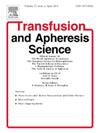旋转血栓弹性测量(ROTEM)在儿科重症监护:单一中心的经验
IF 1.2
4区 医学
Q4 HEMATOLOGY
引用次数: 0
摘要
本研究旨在分析ROTEM对输血实践的影响,并探讨标准凝血试验与ROTEM参数之间的相关性。我们将其设计为回顾性描述性研究,使用2021年1月至2023年2月的单中心数据。所有在PICU接受ROTEM分析作为诊断和治疗管理的一部分的危重儿童都被纳入研究。在分析期间,我们的PICU共对26例儿科患者进行了ROTEM检测,其中一半以上为ECMO患者。为了评估rotem引导下输血对ECMO患者的影响,我们选取同期未接受rotem引导下输血的ECMO患者作为对照组。基于基线特征的倾向评分匹配被用于创建可比较组,每组14例ECMO患者。分析显示,在接受rotem指导治疗的患者和未接受rotem指导治疗的患者之间,输血需求没有显著差异。虽然传统凝血试验与ROTEM的EXTEM和INTEM参数之间没有相关性,但fitemmcf与纤维蛋白原水平之间存在中度正相关。回归模型表明,每增加一个单位的FIBTEM-MCF,纤维蛋白原水平增加0.046 g/L,约占30.4 %的变异性。该研究可能鼓励临床医生在重症监护中使用ROTEM。此外,我们的线性回归模型显示FIBTEM-MCF与纤维蛋白原水平之间存在显著关系。我们已经证明的预测公式可以通过提供一种快速的预测方法来评估凝血状态,从而改善临床决策。本文章由计算机程序翻译,如有差异,请以英文原文为准。
Rotational thromboelastometry (ROTEM) in pediatric intensive care: A single center experience
The study aimed to analyze ROTEM's impact on transfusion practices and investigate the correlation between standard coagulation tests and ROTEM parameters. We designed it as a retrospective descriptive study, using single-center data from January 2021 to February 2023. All critically ill children admitted to PICU who underwent ROTEM analysis as part of their diagnostic and therapeutic management were included in the study. During the analysis period, ROTEM testing was performed on a total of 26 pediatric patients in our PICU, more than half of whom were ECMO patients. To evaluate the impact of ROTEM-guided transfusion on ECMO patients, a control group of ECMO patients who did not receive ROTEM-guided transfusions during the same period was utilized. Propensity score matching, based on baseline characteristics, was employed to create comparable groups of 14 ECMO patients each. The analysis revealed no significant difference in transfusion requirements between those who received ROTEM-guided therapy and those who did not. While no correlation was found between traditional coagulation tests and ROTEM's EXTEM and INTEM parameters, a moderate positive correlation was observed between FIBTEMMCF and fibrinogen levels. A regression model demonstrated that for every unit increase in FIBTEM-MCF, fibrinogen levels increased by 0.046 g/L, accounting for approximately 30.4 % of the variability. The study may encourage clinicians to use ROTEM in the intensive care. Additionally, our linear regression model shows a significant relationship between FIBTEM-MCF and fibrinogen levels. The predictiveformula we have demonstrated may improve clinical decision-making by providing a rapid predictive method to assess coagulation status.
求助全文
通过发布文献求助,成功后即可免费获取论文全文。
去求助
来源期刊
CiteScore
3.60
自引率
5.30%
发文量
181
审稿时长
42 days
期刊介绍:
Transfusion and Apheresis Science brings comprehensive and up-to-date information to physicians and health care professionals involved in the rapidly changing fields of transfusion medicine, hemostasis and apheresis. The journal presents original articles relating to scientific and clinical studies in the areas of immunohematology, transfusion practice, bleeding and thrombotic disorders and both therapeutic and donor apheresis including hematopoietic stem cells. Topics covered include the collection and processing of blood, compatibility testing and guidelines for the use of blood products, as well as screening for and transmission of blood-borne diseases. All areas of apheresis - therapeutic and collection - are also addressed. We would like to specifically encourage allied health professionals in this area to submit manuscripts that relate to improved patient and donor care, technical aspects and educational issues.
Transfusion and Apheresis Science features a "Theme" section which includes, in each issue, a group of papers designed to review a specific topic of current importance in transfusion and hemostasis for the discussion of topical issues specific to apheresis and focuses on the operators'' viewpoint. Another section is "What''s Happening" which provides informal reporting of activities in the field. In addition, brief case reports and Letters to the Editor, as well as reviews of meetings and events of general interest, and a listing of recent patents make the journal a complete source of information for practitioners of transfusion, hemostasis and apheresis science. Immediate dissemination of important information is ensured by the commitment of Transfusion and Apheresis Science to rapid publication of both symposia and submitted papers.

 求助内容:
求助内容: 应助结果提醒方式:
应助结果提醒方式:


